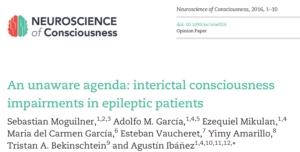An unware agenda: Interictal consciousness impairments in epileptic patients
Neuroscience of Consciousness
Moguilner, S., García, A. M., Mikulan, E., García, M., Vaucheret, E., Amarillo, Y., Bekinschtein, T. A. & Ibáñez, A. (2017). An unware agenda: Interictal consciousness impairments in epileptic patients. Neuroscience of Consciousness. Online: http://bit.ly/2kEZMkE.
En este trabajo proponemos que la epilepsia podría producir afectaciones durables de la consciencia durante el periodo interictal (cuando no ocurren crisis). Proponemos los mecanismos fisiopatológicos posibles para ello y su relación con la red talamocortical y otras organizaciones reticulares. Finalmente evaluamos el potencial traslacional de este enfoque.
Para acceder al paper completo hacé click aquí
An unware agenda: Interictal consciousness impairments in epileptic patients
Neuroscience of Consciousness
Moguilner, S., García, A. M., Mikulan, E., García, M., Vaucheret, E., Amarillo, Y., Bekinschtein, T. A. & Ibáñez, A. (2017). An unware agenda: Interictal consciousness impairments in epileptic patients. Neuroscience of Consciousness. Online: http://bit.ly/2kEZMkE.
Consciousness impairments have been described as a cornerstone of epilepsy. Generalized seizures are usually characterized by a complete loss of consciousness, whereas focal seizures have more variable degrees of responsiveness. In addition to these impairments that occur during ictal episodes, alterations of consciousness have also been repeatedly observed between seizures (i.e. during interictal periods). In this opinion article, we review evidence supporting the novel hypothesis that epilepsy produces consciousness impairments which remain present interictally. Then, we discuss therapies aimed to reduce seizure frequency, which may modulate consciousness between epileptic seizures. We conclude with a consideration of relevant pathophysiological mechanisms. In particular, the thalamocortical network seems to be involved in both seizure generation and interictal consciousness impairments, which could inaugurate a promising translational agenda for epilepsy studies.
To access the full paper please click here



